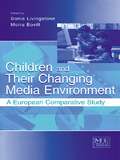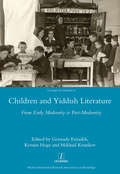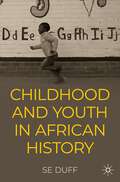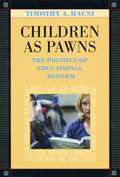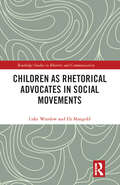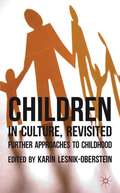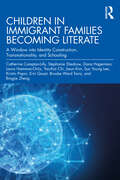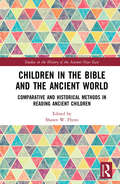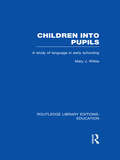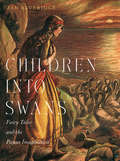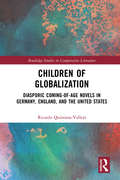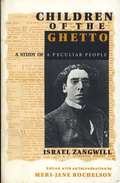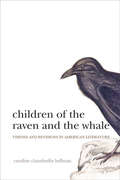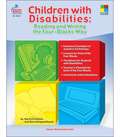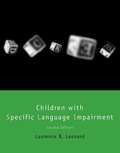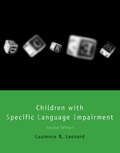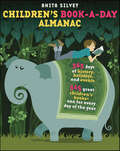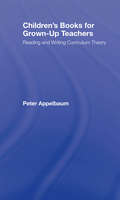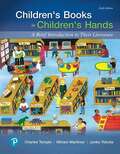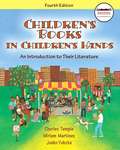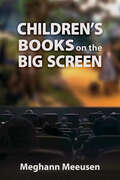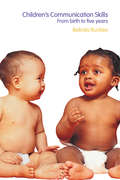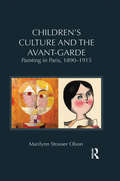- Table View
- List View
Children and Their Changing Media Environment: A European Comparative Study (Routledge Communication Series)
by Sonia Livingstone Moira BovillFocusing on the meanings, uses, and impacts of new media in childhood, family life, peer culture, and the relation between home and school, this volume sets out to address many of the questions, fears, and hopes regarding the changing place of media in the lives of today's children and young people. The scholars contributing to this work argue that such questions--intellectual, empirical, and policy-related--can be productively addressed through cross-national research. Hence, this volume brings together researchers from 12 countries--Belgium, Denmark, Finland, France, Germany, the United Kingdom, Israel, Italy, the Netherlands, Spain, Sweden, and Switzerland--to present original and comprehensive findings regarding the diffusion and significance of new media and information technologies among children. Inspired by parallels and difference between the arrival of television in the family home during the 1950s and the present day arrival of new media, the research is based on in-depth interviews and a detailed comparative survey of 6- to 16-year-olds across Europe and in Israel. The result is a comprehensive, detailed, and fascinating account of how these technologies are rapidly becoming central to the daily lives of young people. As a resource for researchers and students in media and communication studies, leisure and cultural studies, social psychology, and related areas, this volume provides crucial insights into the role of media in the lives of children. The findings included herein will also be of interest to policymakers in broadcasting, technology, and education throughout the world.
Children and Yiddish Literature From Early Modernity to Post-Modernity: From Early Modernity To Post-modernity (Legenda Ser.)
by Gennady Estraikh Kerstin Hoge Krutikov MikhailChildren have occupied a prominent place in Yiddish literature since early modern times, but children’s literature as a genre has its beginnings in the early 20th century. Its emergence reflected the desire of Jewish intellectuals to introduce modern forms of education, and promote ideological agendas, both in Eastern Europe and in immigrant communities elsewhere. Before the Second World War, a number of publishing houses and periodicals in Europe and the Americas specialized in stories, novels and poems for various age groups. Prominent authors such as Yankev Glatshteyn, Der Nister, Joseph Opatoshu, Leyb Kvitko, made original contributions to the genre, while artists, such as Marc Chagall, El Lissitzky and Yisakhar Ber Rybak, also took an active part. In the Soviet Union, meanwhile, children’s literature provided an opportunity to escape strong ideological pressure. Yiddish children’s literature is still being produced today, both for secular and strongly Orthodox communities. This volume is a pioneering collective study not only of children’s literature but of the role played by children in literature.
Children and Youth in African History
by SE DuffThis textbook introduces readers to the academic scholarship on the history of childhood and youth in sub-Saharan Africa, with a particular focus on the colonial and postcolonial eras. In a series of seven chapters, it addresses key themes in the historical scholarship, arguing that age serves as a useful category for historical analysis in African history. Just as race, class, and gender can be used to understand how African societies have been structured over time, so too age is a powerful tool for thinking about how power, youth, and seniority intersect and change over time. This is, then, a work of synthesis rather than of new research based on primary sources. This book will therefore introduce mainstream scholars of the history of childhood and youth to the literature on Africa, and scholars of youth in Africa to debates within the wider field of the history of children and youth.
Children as Pawns: The Politics of Educational Reform
by Timothy A. HacsiHead Start. Bilingual education. Small class size. Social promotion. School funding. Virtually every school system in America has had to face these issues over the past thirty years. Advocates and dissenters have declared confidently that "the research" is on their side. But is it? In the first book to bring together the recent history of educational policy and politics with the research evidence, Timothy Hacsi presents the illuminating, often-forgotten stories of these five controversial topics. He sifts through the complicated evaluation research literature and compares the policies that have been adopted to the best evidence about what actually works. He lucidly explains what the major studies show, what they don't, and how they have been misunderstood and misrepresented. Hacsi shows how rarely educational policies are based on solid research evidence, and how programs that sound plausible simply do not satisfy the complex needs of real children.
Children as Rhetorical Advocates in Social Movements (Routledge Studies in Rhetoric and Communication)
by Luke Winslow Eli MangoldThis book examines “Rhetorical Children” as visible and vocal communicators, shaping public discourse on contentious social issues related to organized labor, civil rights, gun violence, and climate change. This book explores four key social movement case studies: the 1903 Mother Jones-led March of the Mill Children to reform child labor laws, the 1963 Dr. Martin Luther King, Jr.,-led Children’s Crusade to end segregation, the 2018 Parkland student-led March for Our Lives movement to end gun violence, and the ongoing struggle for climate change mitigation led by Swedish activist Greta Thunberg. Through these case studies, the book outlines three rhetorical strategies, namely children’s ability to activate adults’ moral obligation; to invoke threats to natality and lost childhood; and to disrupt social order. It enables readers to better understand rhetorical children and the rhetorical tools required for social movements. Assessing the powerful role children play in shaping public discourse, this book will be of interest to students and scholars in the fields of Communication Studies, Rhetoric, Public Address, Social Movements, and Cultural Studies.
Children in Culture, Revisited
by Karín Lesnik-ObersteinChildren in Culture, Revisited follows on from the first volume, Children in Culture , and is composed of a range of chapters, newly written for this collection, which offer further fully inter- and multidisciplinary considerations of childhood as a culturally and historically constructed identity rather than a constant psycho-biological entity.
Children in Immigrant Families Becoming Literate: A Window into Identity Construction, Transnationality, and Schooling
by Jieun Kim Catherine Compton-Lilly Stephanie Shedrow Dana Hagerman Laura Hamman-Ortiz Yao-Kai Chi Sun Young Lee Kristin Papoi Erin Quast Brooke Ward Taira Bingjie ZhengThis original book offers a meaningful window into the lived experiences of children from immigrant families, providing a holistic, profound portrait of their literacy practices as situated within social, cultural, and political frames. Drawing on reports from five years of an ongoing longitudinal research project involving students from immigrant families across their elementary school years, each chapter explores a unique set of questions about the students’ experiences and offers a rich data set of observations, interviews, and student-created artifacts. Authors apply different sociocultural, sociomaterial, and sociopolitical frameworks to better understand the dimensions of the children’s experiences. The multitude of approaches applied demonstrates how viewing the same data through distinct lenses is a powerful way to uncover the differences and comparative uses of these theories. Through such varied lenses, it becomes apparent how the complexities of lived experiences inform and improve our understanding of teaching and learning, and how our understanding of multifaceted literacy practices affects students’ social worlds and identities. Children in Immigrant Families Becoming Literate is a much-needed resource for scholars, professors, researchers, and graduate students in language and literacy education, English education, and teacher education.
Children in the Bible and the Ancient World: Comparative and Historical Methods in Reading Ancient Children (Studies in the History of the Ancient Near East)
by Shawn FlynnThe topic of children in the Bible has long been under-represented, but this has recently changed with the development of childhood studies in broader fields, and the work of several dedicated scholars. While many reading methods are employed in this emerging field, comparative work with children in the ancient world has been an important tool to understand the function of children in biblical texts. Children in the Bible and the Ancient World broadly introduces children in the ancient world, and specifically children in the Bible. It brings together an international group of experts who help readers understand how children are constructed in biblical literature across three broad areas: children in the Hebrew Bible and the Ancient Near East, children in Christian writings and the Greco-Roman world, and children and materiality. The diverse essays cover topics such as: vows in Ugarit and the Hebrew Bible, obstetric knowledge, infant abandonment, the role of marriage, Greek abandonment texts, ritual entry for children into Christian communities, education, sexual abuse, and the role of archeological figurines in children’s lives. The volume also includes expertise in biological anthropology to study the skeletal remains of ancient children, as well as how ancient texts illuminate Mary’s female maturity. The volume is written in an accessible style suitable for non-specialists, and it is equipped with a helpful resource bibliography that organizes select secondary sources from these essays into meaningful categories for further study. Children in the Bible and the Ancient World is a helpful introduction to any who study children and childhood in the ancient world. In addition, the volume will be of interest to experts who are engaged in historical approaches to biblical studies, while appreciating how the ancient world continues to illuminate select topics in biblical texts.
Children into Pupils: A Study of Language in Early Schooling (Routledge Library Editions: Education)
by Mary WillesThis book makes work in the field of sociolinguistics easily accessible to working teachers and to teachers in training. It focuses on the crucial first weeks that children spend in school, and deals with talk as a joint production, in which teachers and pupils are engaged from the earliest stages of the educational process. Using a variety of research methods and observations, Mary Willes captures the reality of what goes on in the classroom, and describes how young children develop both linguistic and cognitive skills in this social context. In addition, she examines classrooms where teachers have to find ways of interacting with young speakers of a mother tongue other than English.
Children into Swans
by Jan BeveridgeFairy tales are alive with the supernatural - elves, dwarfs, fairies, giants, and trolls, as well as witches with magic wands and sorcerers who cast spells and enchantments. Children into Swans examines these motifs in a range of ancient stories. Moving from the rich period of nineteenth-century fairy tales back as far as the earliest folk literature of northern Europe, Jan Beveridge shows how long these supernatural features have been a part of storytelling, with ancient tales, many from Celtic and Norse mythology, that offer glimpses into a remote era and a pre-Christian sensibility. The earliest stories often show significant differences from what we might expect. Elves mingle with Norse gods, dwarfs belong to a proud clan of magician-smiths, and fairies are shape-shifters emerging from the hills and the sea mist. In story traditions with roots in a pre-Christian imagination, an invisible other world exists alongside our own. From the lost cultures of a thousand years ago, Children into Swans opens the door on some of the most extraordinary worlds ever portrayed in literature - worlds that are both starkly beautiful and full of horrors.
Children into Swans: Fairy Tales and the Pagan Imagination
by Jan BeveridgeFairy tales are alive with the supernatural - elves, dwarfs, fairies, giants, and trolls, as well as witches with magic wands and sorcerers who cast spells and enchantments. Children into Swans examines these motifs in a range of ancient stories. Moving from the rich period of nineteenth-century fairy tales back as far as the earliest folk literature of northern Europe, Jan Beveridge shows how long these supernatural features have been a part of storytelling, with ancient tales, many from Celtic and Norse mythology, that offer glimpses into a remote era and a pre-Christian sensibility. The earliest stories often show significant differences from what we might expect. Elves mingle with Norse gods, dwarfs belong to a proud clan of magician-smiths, and fairies are shape-shifters emerging from the hills and the sea mist. In story traditions with roots in a pre-Christian imagination, an invisible other world exists alongside our own. From the lost cultures of a thousand years ago, Children into Swans opens the door on some of the most extraordinary worlds ever portrayed in literature - worlds that are both starkly beautiful and full of horrors.
Children of Globalization: Diasporic Coming-of-Age Novels in Germany, England, and the United States (Routledge Studies in Comparative Literature)
by Ricardo Quintana-VallejoChildren of Globalization is the first book-length exploration of contemporary Diasporic Coming-of-age Novels in the context of globalized and de facto multicultural societies. Diasporic Coming-of-age Novels subvert the horizon of expectations of the originating and archetypal form of the genre, the traditional Bildungsroman, which encompasses the works of Johann Wolfgang von Goethe, Charles Dickens, and Jane Austen, and illustrates middle-class, European, "enlightened," and overwhelmingly male protagonists who become accommodated citizens, workers, and spouses whom the readers should imitate. Conversely, Diasporic Coming-of-age Novels have manifold ways of defining youth and adulthood. The culturally-hybrid protagonists, often experiencing intersectional oppression due to their identities of race, gender, class, or sexuality, must negotiate what it means to become adults in their own families and social contexts, at times being undocumented or otherwise unable to access full citizenship, thus enabling complex and variegated formative processes that beg the questions of nationhood and belonging in increasingly globalized societies worldwide.
Children of the Dark House: Text and Context in Faulkner
by Noel PolkThis book by a major scholar of William Faulkner’s writings collects choice selections of his Faulkner criticism from the past fifteen years. Its publication underscores the significance of his indispensable work in Faulkner studies, both in criticism and in the editing of Faulkner’s texts. Here, Polk’s focus is mainly upon the context of Freudian themes, expressly in the works written between 1927 and 1932, the period in which Faulkner wrote and ultimately revised Sanctuary, a novel to which Polk has given concentrated study during his distinguished career. He has connected the literature with the life in a way not achieved in previous criticism. Although other critics, notably John T. Irwin and Andre Bleikasten, have explored Oedipal themes, neither perceived them as operating so completely at the center of Faulkner’s work as Polk does in these essays.
Children of the Ghetto: A Study of a Peculiar People
by Israel Zangwill Meri-Jane RochelsonIn its first appearance in 1892, Israel Zangwill's Children of the Ghetto created a sensation in both England and America, becoming the first Anglo-Jewish bestseller and establishing Zangwill as the literary voice of Anglo-Jewry. A novel set in late nineteenth-century London, Children of the Ghetto gave an inside look into an immigrant community that was almost as mysterious to the more established middle-class Jews of Britain as to the non-Jewish population, providing a compelling analysis of a generation caught between the ghetto and modern British life. This volume brings back to print the 1895 edition of Children of the Ghetto, the latest American version known to have been corrected by the author. Meri-Jane Rochelson places the novel in proper context by providing a biographical, historical, and critical introduction; a bibliography of primary and secondary sources; and notes on the text, making this ground-breaking novel accessible to a new generation of readers, both Jewish and non-Jewish alike.
Children of the Raven and the Whale: Visions and Revisions in American Literature
by Caroline Chamberlin HellmanTaking its cue from Perry Miller’s 1956 classic of American literary criticism, The Raven and the Whale: The War of Words and Wits in the Era of Poe and Melville, Caroline Chamberlin Hellman’s new book examines ways in which contemporary multi-ethnic writers of the United States have responded to nineteenth- and early twentieth century texts historically central to the American literary canon.Each chapter of Children of the Raven and the Whale looks down the roads American literature ultimately traveled, examining pairs and constellations of texts in conversation. In their rewritings and layerings of new stories over older ones, contemporary writers forge ahead in their interrogations of a spectrum of American experience, whether they or their characters are native to the United States, first- or second-generation immigrants, or transnational. Revealing the traces of texts by writers such as Walt Whitman, Herman Melville, Nathaniel Hawthorne, F. Scott Fitzgerald, Ernest Hemingway, Richard Wright, and James Baldwin lying beneath contemporary American literature by Chang-rae Lee, Jonathan Lethem, Jhumpa Lahiri, Junot Díaz, Joseph O’Neill, Colum McCann, and Ta-Nehisi Coates, Hellman posits the existence of a twenty-first-century American renaissance.
Children with Disabilities: Reading and Writing the Four-Blocks Way
by Karen A. Erickson David A. KoppenhaverThis collection of ideas, strategies, and resources includes information on Self-Selected Reading, Guided Reading, Writing, and Working with Words. It also includes strategies for reading and writing success in special-education classrooms, variations for students with disabilities, teacher's checklists, IEP goal suggestions, examples of assistive technology, and answers to commonly asked questions.
Children with Specific Language Impairment
by Laurence B. LeonardChildren with specific language impairment (SLI) show a significant deficit in spoken language that cannot be attributed to neurological damage, hearing impairment, or intellectual disability. More prevalent than autism and at least as prevalent as dyslexia, SLI affects approximately seven percent of all children; it is longstanding, with adverse effects on academic, social, and (eventually) economic standing. The first edition of this work established Children with Specific Language Impairment as the landmark reference on this condition, considering not only the disorder's history, possible origins, and treatment but also what SLI might tell us about language organization and development in general. This second edition offers a complete update of the earlier volume. Much of the second edition is completely new, reflecting findings and interpretations based on the hundreds of studies that have appeared since the publication of the first edition in 1997. Topics include linguistic details (descriptive and theoretical), word and sentence processing findings, genetics, neurobiology, treatment, and comparisons to such conditions as autism spectrum disorders, ADHD, and dyslexia. The book covers SLI in children who speak a wide range of languages, and, although the emphasis is on children, it also includes studies of adults who were diagnosed with SLI as children or are the parents of children with SLI. Written by a leading scholar in the field, Children with Specific Language Impairment offers the most comprehensive, balanced, and unified treatment of SLI available.
Children with Specific Language Impairment (Language, Speech, and Communication)
by Laurence B. LeonardThe landmark reference in the field, completely updated: a comprehensive treatment of a disorder that is more prevalent than autism. Children with specific language impairment (SLI) show a significant deficit in spoken language that cannot be attributed to neurological damage, hearing impairment, or intellectual disability. More prevalent than autism and at least as prevalent as dyslexia, SLI affects approximately seven percent of all children; it is longstanding, with adverse effects on academic, social, and (eventually) economic standing. The first edition of this work established Children with Specific Language Impairment as the landmark reference on this condition, considering not only the disorder's history, possible origins, and treatment but also what SLI might tell us about language organization and development in general. This second edition offers a complete update of the earlier volume.Much of the second edition is completely new, reflecting findings and interpretations based on the hundreds of studies that have appeared since the publication of the first edition in 1997. Topics include linguistic details (descriptive and theoretical), word and sentence processing findings, genetics, neurobiology, treatment, and comparisons to such conditions as autism spectrum disorders, ADHD, and dyslexia. The book covers SLI in children who speak a wide range of languages, and, although the emphasis is on children, it also includes studies of adults who were diagnosed with SLI as children or are the parents of children with SLI.Written by a leading scholar in the field, Children with Specific Language Impairment offers the most comprehensive, balanced, and unified treatment of SLI available.
Children's Book-a-Day Almanac
by Anita SilveyPart fun- and information-filled almanac, part good book guide, the Children's Book-a-Day Almanac is a new way to discover a great children's book--every day of the year!This fresh, inventive reference book is a dynamic way to showcase the gems, both new and old, of children's literature. Each page features an event of the day, a children's book that relates to that event, and a list of other events that took place on that day. Always informative and often surprising, celebrate a year of literature for children with The Children's Book-a-Day Almanac.
Children's Books for Grown-Up Teachers: Reading and Writing Curriculum Theory (Studies in Curriculum Theory Series)
by Peter AppelbaumTeachers and prospective teachers read children's books, but that reading is often done as a "teacher" – that is, as planning for instruction – rather than as a "reader" engaged with the text. Children’s Books for Grown-Up Teachers models the kind of thinking about teaching and learning – the sort of curriculum theorizing – accomplished through teachers’ interactions with the everyday materials of teaching. It starts with children’s books, branches out into other youth culture texts, and subsequently to thinking about everyday life itself. Texts of curriculum theory describe infrastructures that support the crafts of inquiry and learning, and introduce a new vocabulary of poaching, weirding, dark matter, and jazz. At the heart of this book is a method of reading; Each reader pulls idiosyncratic concepts from children’s books and from everyday life. Weaving these concepts into a discourse of curriculum theory is what makes the difference between "going through the motions of teaching" and "designing educational experiences. This book was awarded the 2009 AERA Division B (Curriculum Studies) Outstanding Book Award.
Children's Books in Children's Hands: A Brief Introduction to Their Literature
by Charles Temple Junko Yokota Miriam MartinezChildren’s Books in Children’s Hands: A Brief Introduction to Their Literature familiarizes current and future teachers with the best and most recent books for children. The renowned author team presents richly illustrated, practical ideas for sharing literature with children as a source of enjoyment and inspiration that will last them all their lives. This authoritative, captivating, and popular guide establishes a roadmap for understanding the world of children’s literature, including its writers, illustrators, editors, and critics, while also providing a strong emphasis on books from many cultural groups. <p><P>The 6th Edition now includes full color illustrations and art, newer title annotations, new teaching ideas, coverage of shifting changes in genres, and thorough coverage of multicultural and international books.
Children's Books in Children's Hands: An Introduction to Their Literature
by Junko Yokota Charles A. Temple Miriam A. MartinezPre-service and in-service teachers alike benefit from the experience of renowned authors Charles Temple, Miriam Martinez, and Junko Yokota as they share a wealth of richly illustrated, practical ideas for sharing literature with children. The authors focus on creating an understanding of how literature works and how children respond to literature, they provide a wide range of good books to use with children, and they suggest ways to guide children into books and help them enjoy the experience. Dozens of new authors and books have been added to this new edition of Children's books in Children's Hands: An Introduction to Their Literature, 4e, making it interesting and current, and the continued emphasis on cultural diversity includes a new chapter on international books.
Children's Books on the Big Screen (Children's Literature Association Series)
by Meghann MeeusenIn Children’s Books on the Big Screen, Meghann Meeusen goes beyond the traditional adaptation approach of comparing and contrasting the similarities of film and book versions of a text. By tracing a pattern across films for young viewers, Meeusen proposes that a consistent trend can be found in movies adapted from children’s and young adult books: that representations of binaries such as male/female, self/other, and adult/child become more strongly contrasted and more diametrically opposed in the film versions. The book describes this as binary polarization, suggesting that starker opposition between concepts leads to shifts in the messages that texts send, particularly when it comes to representations of gender, race, and childhood. After introducing why critics need a new way of thinking about children’s adapted texts, Children’s Books on the Big Screen uses middle-grade fantasy adaptations to explore the reason for binary polarization and looks at the results of polarized binaries in adolescent films and movies adapted from picture books. Meeusen also digs into instances when multiple films are adapted from a single source such as The Wonderful Wizard of Oz and ends with pragmatic classroom application, suggesting teachers might utilize this theory to help students think critically about movies created by the Walt Disney corporation. Drawing from numerous popular contemporary examples, Children’s Books on the Big Screen posits a theory that can begin to explain what happens—and what is at stake—when children’s and young adult books are made into movies.
Children's Communication Skills: From Birth to Five Years
by Belinda BuckleyBased on a huge body of research in child language and communication development, Children's Communication Skills uses a clear format to set out the key stages of communication development in babies and young children. Its aim is to increase awareness in professionals working with children of what constitutes human communication and what communication skills to expect at any given stage. Illustrated throughout with real-life examples, this informative text addresses: normal development of verbal and non-verbal communication skills the importance of play in developing these skills developmental communication problems bilingualism, cognition and early literacy development working with parents of children with communication difficulties. Features designed to make the book an easy source of reference include chapter summaries, age-specific skills tables, sections on warning signs that further help may be needed, and a glossary of key terms. It will be of great use to a wide range of professionals in training or working in health, education and social care.
Children's Culture and the Avant-Garde: Painting in Paris, 1890-1915 (Children's Literature and Culture #86)
by Marilynn Strasser OlsonThis volume explores the mutual influences between children’s literature and the avant-garde. Olson places particular focus on fin-de-siècle Paris, where the Avant-garde was not unified in thought and there was room for modernism to overlap with children’s literature and culture in the Golden Age. The ideas explored by artists such as Florence Upton, Henri Rousseau, Sir William Nicholson, Paula Modersohn-Becker, and Marc Chagall had been disseminated widely in cultural productions for children; their work, in turn, influenced children’s culture. These artists turned to children’s culture as a "new way of seeing," allied to a contemporary interest in international artistic styles. Children’s culture also has strong ties to decadence and to the grotesque, the latter of which became a distinctively Modernist vision. This book visits the qualities of the era that were defined as uniquely childlike, the relation of childhood to high and low art, and the relation of children’s literature to fin-de-siècle artistic trends. Topics of interest include the use of non-European figures (the Golliwogg), approaches to religion and pedagogy, to oppression and motherhood, to Nature in a post-Darwinian world, and to vision in art and life. Olson’s unique focus covers new ground by concentrating not simply on children's literature, but on how childhood experiences and culture figure in art.
